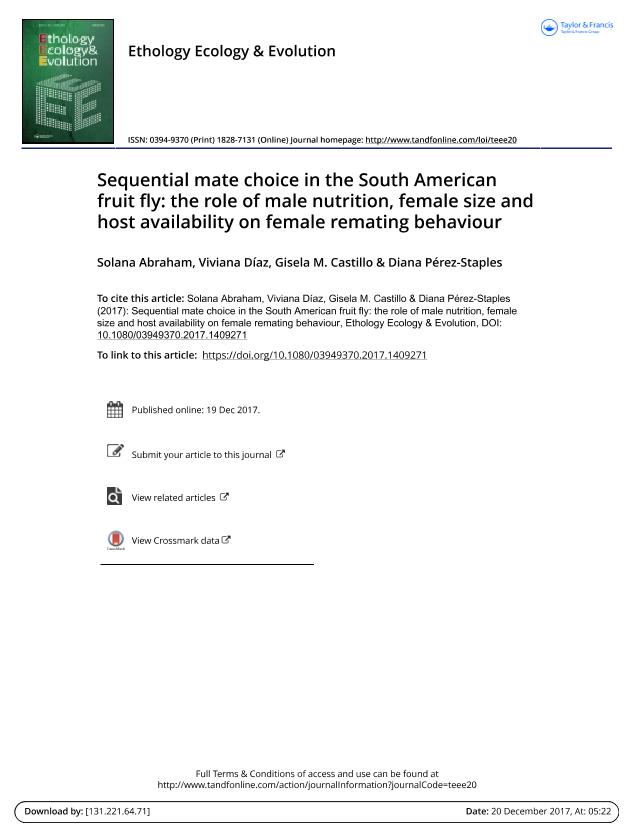Mostrar el registro sencillo del ítem
dc.contributor.author
Abraham, Solana

dc.contributor.author
Díaz, Viviana
dc.contributor.author
Castillo, Gisela M.
dc.contributor.author
Perez Staples, Diana Folger

dc.date.available
2018-03-27T19:27:58Z
dc.date.issued
2017-12-19
dc.identifier.citation
Abraham, Solana; Díaz, Viviana; Castillo, Gisela M.; Perez Staples, Diana Folger; Sequential mate choice in the South American fruit fly: the role of male nutrition, female size and host availability on female remating behaviour; Universita Degli Studi Di Firenze; Ethology Ecology & Evolution; 19-12-2017; 1-14
dc.identifier.issn
0394-9370
dc.identifier.uri
http://hdl.handle.net/11336/40199
dc.description.abstract
After mating, female sexual receptivity usually decreases and returns, depending on various factors, one of which can be the quality of the first or second male. Here, we tested in the South American fruit fly Anastrepha fraterculus if female remating is conditioned by the quality of the second male, when females encounter sequential mates (under no-choice conditions) and when females have the opportunity to choose between well-nourished and malnourished males, both for mating and for remating. Additionally, we tested if other factors such as female size and the opportunity to oviposit influenced females’ remating propensity. We found that females remate more often when they encounter a male of good nutritional condition, under both choice and no-choice conditions, and when females had access to a host to oviposit. Other traits of the sequential mate, such as male mating status (virgin or mated), male density (one or three males) and female size, had no effect on female remating behaviour. Plasticity in female post-copulatory mating under both choice and no-choice conditions indicates that A. fraterculus females are able to discriminate between males with different nutritional qualities without needing to compare them directly. Females were more choosy when remating, probably as a result of previous sexual experience, yet it remains to be seen which cues females use to distinguish between males. We discuss our results in the context of female pre- and post-copulatory mating decisions.
dc.format
application/pdf
dc.language.iso
eng
dc.publisher
Universita Degli Studi Di Firenze

dc.rights
info:eu-repo/semantics/openAccess
dc.rights.uri
https://creativecommons.org/licenses/by-nc-sa/2.5/ar/
dc.subject
Protein Diet
dc.subject
Mate Choice
dc.subject
Remating
dc.subject
Oviposition Behaviour
dc.subject
Tephritidae
dc.subject.classification
Otras Ciencias Biológicas

dc.subject.classification
Ciencias Biológicas

dc.subject.classification
CIENCIAS NATURALES Y EXACTAS

dc.title
Sequential mate choice in the South American fruit fly: the role of male nutrition, female size and host availability on female remating behaviour
dc.type
info:eu-repo/semantics/article
dc.type
info:ar-repo/semantics/artículo
dc.type
info:eu-repo/semantics/publishedVersion
dc.date.updated
2018-03-21T15:55:01Z
dc.journal.pagination
1-14
dc.journal.pais
Italia

dc.description.fil
Fil: Abraham, Solana. Consejo Nacional de Investigaciones Científicas y Técnicas. Centro Científico Tecnológico Conicet - Tucumán. Planta Piloto de Procesos Industriales Microbiológicos; Argentina
dc.description.fil
Fil: Díaz, Viviana. Consejo Nacional de Investigaciones Científicas y Técnicas. Centro Científico Tecnológico Conicet - Tucumán. Planta Piloto de Procesos Industriales Microbiológicos; Argentina
dc.description.fil
Fil: Castillo, Gisela M.. Consejo Nacional de Investigaciones Científicas y Técnicas. Centro Científico Tecnológico Conicet - Tucumán. Planta Piloto de Procesos Industriales Microbiológicos; Argentina
dc.description.fil
Fil: Perez Staples, Diana Folger. Universidad Veracruzana; México
dc.journal.title
Ethology Ecology & Evolution

dc.relation.alternativeid
info:eu-repo/semantics/altIdentifier/doi/http://dx.doi.org/10.1080/03949370.2017.1409271
dc.relation.alternativeid
info:eu-repo/semantics/altIdentifier/url/https://www.tandfonline.com/doi/full/10.1080/03949370.2017.1409271
Archivos asociados
